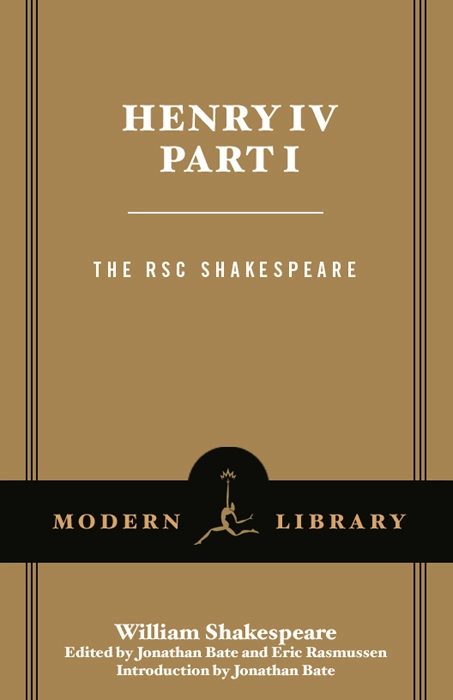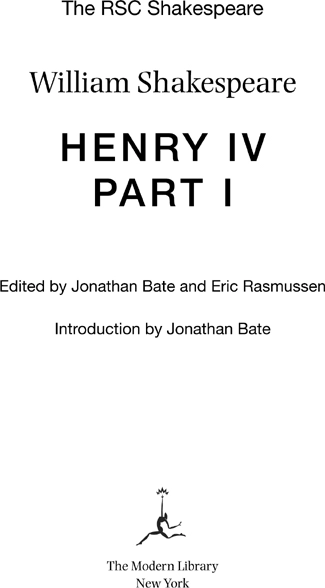Henry IV, Part 1

The RSC Shakespeare
Edited by Jonathan Bate and Eric Rasmussen
Chief Associate Editors: Héloïse Sénéchal and Jan Sewell
Associate Editors: Trey Jansen, Eleanor Lowe, Lucy Munro, Dee Anna Phares
Henry IV Part I
Textual editing: Eric Rasmussen
Introduction and Shakespeare’s Career in the Theater: Jonathan Bate
Commentary: Jan Sewell and Héloïse Sénéchal
Scene-by-Scene Analysis: Esme Miskimmin
In Performance: Karin Brown (RSC stagings), Jan Sewell (overview)
The Actor’s Voice and the Director’s Cut
(interviews by Jonathan Bate and Kevin Wright): Michael Pennington, Adrian Noble, Michael Boyd
Editorial Advisory Board
Gregory Doran, Chief Associate Director, Royal Shakespeare Company
Jim Davis, Professor of Theatre Studies, University of Warwick, UK
Charles Edelman, Senior Lecturer, Edith Cowan University, Western Australia
Lukas Erne, Professor of Modern English Literature, Université de Genève, Switzerland
Akiko Kusunoki, Tokyo Woman’s Christian University, Japan
Jacqui O’Hanlon, Director of Education, Royal Shakespeare Company
Ron Rosenbaum, author and journalist, New York, USA
James Shapiro, Professor of English and Comparative Literature, Columbia University, USA
Tiffany Stern, Professor of English, University of Oxford, UK

CONTENTS
Introduction
Tragical-Comical-Historical-Pastoral
Harry to Harry
Honor Versus Instinct
The Prince as Machiavel?
Reformation and Rejection
About the Text
Key Facts
The First Part of Henry the Fourth, with the Life and Death of Henry Surnamed Hotspur
Textual Notes
Oaths from the Quarto
Scene-by-Scene Analysis
Synopsis of Henry IV Part II
Henry IV in Performance: The RSC and Beyond
Four Centuries of Henry IV: An Overview
At the RSC
The Actor’s Voice and the Director’s Cut: Interviews with Michael Pennington, Adrian Noble, and Michael Boyd
Shakespeare’s Career in the Theater
Beginnings
Playhouses
The Ensemble at Work
The King’s Man
Shakespeare’s Works: A Chronology
Kings and Queens of England: From the History Plays to Shakespeare’s Lifetime
The History Behind the Histories: A Chronology
Further Reading and Viewing
References
Acknowledgments and Picture Credits
INTRODUCTION
TRAGICAL-COMICAL-HISTORICAL-PASTORAL
Shakespeare’s art of mingling comedy, history, and tragedy reached its peak in the two parts of Henry IV. As history, the plays paint a panorama of England, embracing a wider social range than any previous historical drama as the action moves from court to tavern, council chamber to battlefield, city to country, Archbishop and Lord Chief Justice to whore and thief. As comedy, they tell the story of a prodigal son’s journey from youth to maturity and an old rogue’s art of surviving by means of jokes, tall tales, and the art of being not only witty in himself, but the cause that wit is in other men. As tragedy, they reveal the slow decline of a king who cannot escape his past, the precipitate demise of an impetuous young warrior who embodies both the glory and the futility of military heroism, and the heartbreaking dismissal of a substitute father who has loved a prince with a warmth of which his true father is incapable.
The action begins some time after the events that ended Shakespeare’s earlier play, Richard II. Henry Bullingbrook has usurped the throne of King Richard, who has been murdered. But now the rebels who helped Henry to the throne have turned against him. Whereas Richard II conformed to the traditional structure of tragedy—the story of the fall of a powerful man—the Henry IV plays adopt a wider perspective. Richard II had been written entirely in verse, the medium of royal and aristocratic characters, whereas long stretches of the Henry IV plays are in prose, the medium of the common people. The little scene with the Carriers at the tavern just before the highway robbery is a miniature of ordinary working-day life and common speech: “This house is turned upside down since Robin the ostler died.”
The deep structure of the two parts of Henry IV is that not of tragedy but of pastoral comedy. They were written around the same time as Much Ado About Nothing and As You Like It, when Shakespeare’s comic muse was at its zenith. They are his most enjoyable history plays because they are his funniest—and in the figure of Sir John Falstaff they introduce his greatest comic character—but they also share with the comedies a technique of counterpointing the intrigue of court and power politics against what has been called the “green” or “festive” world.
The traditional comic pattern turns on the successful effort of a young man to outwit an opponent and possess the girl of his choice. The girl’s father, or some other authority figure of the older generation, resists the match, but is outflanked, often thanks to an ingenious scheme devised by a clever servant, perhaps involving disguise or flight (or both). The union of the lovers brings a renewed sense of social integration, expressed by some kind of festival at the climax of the play—a marriage, a dance, or a feast. All right-thinking people come over to the side of the lovers, but in Shakespearean comedy there is usually a party pooper, a figure who refuses to be assimilated into the harmony—Malvolio in Twelfth Night, Don John in Much Ado About Nothing, Jaques in As You Like It, Shylock in The Merchant of Venice. The key to the two parts of Henry IV is that they take the comic structure and apply it to Prince Harry—with the difference that, instead of his courtship (which ends up being tacked on very briefly at the end of Henry V), the action turns on his maturation from wild youth to exemplary warrior prince and statesman. And, in a brilliant reversal, the figure who is isolated at the end is not the party pooper but the embodiment of the festive spirit: Falstaff. Comedy is thus placed in opposition to the march of history. The necessity to reject Falstaff in the name of historical destiny and social order is why the final resolution is tinged with the feeling of tragedy.
The distinctive feature of pastoral comedy is that the action develops by means of a shift of location from the everyday world of work, business, politics, patriarchy, and power to a “green” or “festive” place of play, leisure, anarchy, feminine influence, and love—the wood in A Midsummer Night’s Dream, Belmont in The Merchant of Venice, the Forest of Arden in As You Like It, rural Bohemia in The Winter’s Tale. After the comic resolution is achieved, there has to be a return to the normative world, but recreative change has been effected by the values of the festive world. In Henry IV Part I, a tavern in Eastcheap plays the part of the festive world. In Part II, there is a reprise of that setting, but also a rural green world. As in the comedies, the shuttle between contrasting worlds and contradictory value systems creates the dialectic of the drama. But because of the calling of the prince to power, there can be no reconciliation between the value systems. Prince Hal announces in his first soliloquy that his time of “playing holidays” and “loose behaviour” will be but an interlude before he takes upon himself the mantle of historical duty.
HARRY TO HARRY
Richard II had followed the tragic pattern of a mismatch between the character of a man of high estate and the demands of his position as a ruler. It juxtaposed the fall of King Richard to the rise of Henry Bullingbrook, comparing them to a pair of buckets on a pulley, one descending into a well as the other ascends. Once Bullingbrook has become King Henry IV, the pattern is reasserted and reversed in the next generation. Henry sees his son seeming to become another Richard, a time waster surrounding himself with unsuitable companions and allowing the country to run to seed. He sees himself— a soldier, a man of decision and action—not in his son, but in Hotspur, child of the Percy family who had helped him to displace Richard from the throne.
Historically, Henry Percy, known as Hotspur, was more than twenty years older than Prince Henry (usually called Harry and, by Falstaff alone, Hal), the future King Henry V, victor of Agincourt. With his habitual dramatic license, Shakespeare altered history and made them rival youths of the same generation. Henry IV’s nightmare of history repeating itself is that Hotspur will play his own role to his son’s Richard.
1 comment